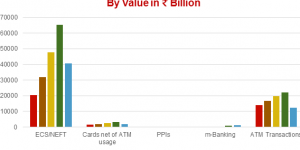By S. S. Mundra, Former Deputy Governor, Reserve Bank of India

An accusation that has come to be levied against the banking sector in the aftermath of the Financial Crisis is that it has failed to be inclusive. Let me tell you that the Indian banking system is not alone in failing the inclusion test. It is only the degree of exclusion that varies between different jurisdictions. The Financial Inclusion Action Plan (FIAP) developed by the G20 Global Partnership for Financial Inclusion mentions that the universal financial inclusion initiative requires bringing the 2.5 billion people (or about half the working age population) currently excluded, into the formal financial system.
That brings us to the question how inclusive is the Indian financial system? Census 2011 gives us some answers. Out of 24.67 crore households in the country, only about 14.48 crore or 58.70 per cent households had access to banking services. Further, of the 16.78 crore rural households only about 9.14 crore or 54.46 per cent households were availing of banking services. But that is only one aspect of the financial exclusion story. The statistics on number of individuals or households that are credit-linked makes for an even more gloomy reading. The World Bank Findex Survey (2012) points out that only about 35% of Indian adults had access to a formal bank account and a meager 8% borrowed formally in the last 12 months. If we were to broaden the canvas and examine the exclusion in the other financial segments of insurance and securities market, the situation is far worse.
Initial Efforts at Financial Inclusion
Having recognised early the social and economic imperatives of broader financial inclusion, both Government and the Reserve Bank have pursued this goal over the last several decades, but with limited success. Starting with the nationalization of banks, priority sector lending requirements, launching of Lead Bank Scheme, establishment of Regional Rural Banks (RRBs), Service Area Approach, Self-Help Group-Bank Linkage Programme- all these innovative programmes were launched with the aim of taking banking services to the masses. Starting in 1990s, however, the focus shifted to strengthening financial institutions as part of financial sector reforms. Despite all the above efforts, the extent of financial exclusion has remained staggering.
Why did these efforts fail?
The target driven approach to social banking could be counted as one of the main reasons for the failure of these efforts as these initiatives could never become part of the business strategies of banks. The banks were more interested in somehow trying to meet the lending targets, mostly at subsidized rates of interest, or with subsidy from the Government under various government directed schemes. The banks never treated social banking as a viable and profitable business proposition. They always worked under the presumption that the poor can neither pay normal interest rates nor could they earn enough without subsidies; while in reality the poor continued to pay exorbitant interest rates to informal sources of finance. For any activity to become sustainable and scalable it has to be viable. Regrettably, there has never been a concerted effort on the part of the banking system to identify specific business opportunities within these groups and to develop viable business models to realize them. I would like to reiterate our firm belief that banking for poor is viable and scalable only on commercial lines, of course, without an exploitative intent.
Reform Era Setback
During the period starting mid 1980s and till about 2005, the regulatory focus shifted to consolidation and profitability of banks. Since social initiatives, as argued earlier, were not integrated with business plans and were thought of as non-viable, they were the first casualties. A number of rural branches were closed down or merged or were shifted to semi-urban areas as they were considered unviable.
Excessive Reliance on Public Sector Banks
The thrust of social initiatives has always been on the public sector banks while the private sector banks and foreign banks have not been given adequate social obligations. Besides, too many authorities involved in pursuing financial inclusion also, at times, resulted in dissipation of structured and planned efforts.
What has changed now?
In the last few years, it has been realized that for financial inclusion to become a reality, there has to be a sustainable business and delivery model. Further, availability of technology as an enabler has now created avenues for developing cost effective solutions for the mammoth task of providing banking services to six lakh plus villages in the country. The lessons learnt from the initial attempts at promoting financial inclusion have also proved to be vital inputs in recalibrating our financial inclusion strategy.
RBI’s Approach to Financial Inclusion
The failure to achieve meaningful progress in financial inclusion forced the regulators and policy makers to have a rethink on the approach. It began with defining what Financial Inclusion actually meant and where should the energies be focused. RBI has defined Financial Inclusion as the process of ensuring access to appropriate financial products and services needed by all sections of the society in general and vulnerable groups such as weaker sections and low income groups in particular, at an affordable cost in a fair and transparent manner by regulated, mainstream institutional players. Thus, financial inclusion has two fold objectives:
To connect the excluded with the formal banking system in order to help them gain an understanding of the financial services available and equipping them with the confidence to make informed financial decisions.
Providing door step banking services to all the six lakh villages and meeting their life cycle financial needs through appropriate savings, credit, remittance and insurance products.
Planned and Structured Approach
RBI has been following a planned and structured approach to address the twin issues of demand and supply of financial services. The efforts have been aimed at creating an enabling environment for the banks. Wide-ranging strategies from a relaxation of regulatory guidelines to provision of new products and supportive measures have been adopted to achieve sustainable and scalable Financial Inclusion.
Bank- Led Model & Leveraging Technology
RBI has advocated a bank-led model for financial inclusion with thrust on leveraging technology. We firmly believe that the success of FI initiatives greatly depends on technology which would enable emergence of cost efficient delivery models. Though we have advocated the use of technology, we are agnostic to the platform to be used for pursuing financial inclusion objectives. Banks have been accorded the freedom to adopt solutions which can be easily scaled up and customized as per their requirements.
Simplified branch authorisation
RBI has considerably relaxed the branch opening norms for banks whereby they do not require prior RBI permission for opening branches in centres with population less than 1 lakh. To further step up the opening of branches in unbanked centres, banks were mandated to open at least 25 per cent of their new branches in unbanked rural centres. Banks have also been advised to consider frontloading (prioritizing) the opening of branches in unbanked rural centres over a three year cycle co-terminus with their Financial Inclusion Plans.
Combination of Branch and BC Structure to deliver Financial Inclusion- ICT Based Accounts – through BCs
RBI has been advocating a combination of Brick and Mortar structure and the BC network to extend financial inclusion, especially in geographically dispersed areas. In order to provide efficient and cost-effective banking services in the unbanked and remote corners of the country, RBI directed commercial banks to provide ICT based banking services through BCs. These ICT enabled banking services have CBS connectivity to provide all banking services including deposit and withdrawal of money in the financially excluded regions. The use of smart cards, hand held devices / POS machines along with bio-metric authentication facilitates digitization of Financial Inclusion process.
Opening of Basic Saving Bank Deposit Accounts (No-frills accounts)
On the products side, banks were directed to make available Basic Savings Bank Deposit Accounts (BSBDAs) for all individuals with zero minimum balance and facility of ATM card/Debit card, effectively making opening of a basic savings account a fundamental right for every eligible Indian citizen. Further, banks were also advised to provide in-built overdrafts in such basic savings accounts so as to meet the emergency credit needs of the customer and prevent them from having to approach money lenders in distress situations. The provision for entrepreneurial credit has also been simplified in the form of KCC for farm sector households and GCC for non-farm sector households.
Relaxed KYC norms
One of the major constraints faced by the people in getting linked to the formal financial system was the strict Know Your Customer (KYC) norms prescribed for opening bank accounts. To facilitate easy opening of accounts, especially for small customers, the KYC guidelines have been simplified to the extent that these accounts can be opened by way of a self-certification in the presence of bank officials. Further, to leverage upon the UIDAI initiative, RBI has allowed Aadhaar, to be used as one of the eligible documents for meeting the KYC requirements for opening a bank account. Very recently, the RBI has also allowed banks to use the E-Aadhaar facility provided by UIDAI for KYC purposes.
Pricing of advances freed
Banks have been provided the freedom to decide the pricing of loans given to customers with a view to ensuring the economic viability of banks’ Financial Inclusion initiatives.
Courtesy: RBI.org







